
Myth: To Ripen Green Tomatoes, Set Them on a Sunny Windowsill
FACT: A common misconception on how ripen tomatoes is that you need a lot of light, but sunlight isn’t actually needed. For slow ripening, put tomatoes in a cool basement and wrap them individually in newspaper to contain the ethylene gas given off by the fruit that hastens ripening. Store both ripe and unripe fruits together for faster results.
Discover 12 more mistakes you’re making with your tomato garden.
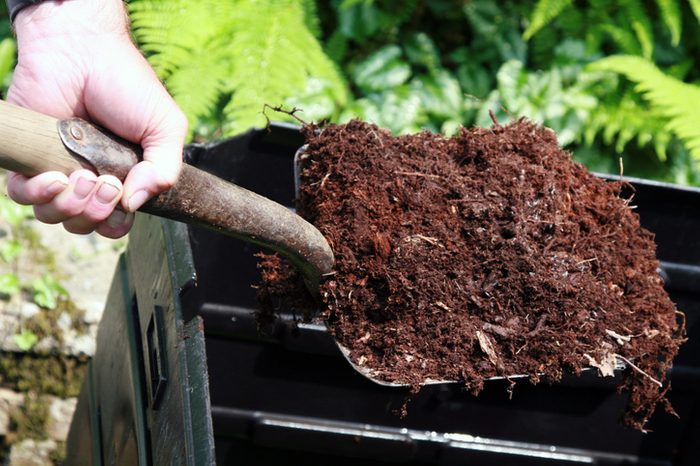
Myth: Compost Bins and Piles Smell Awful
FACT: If your compost pile has anything but a pleasant earthy smell, it’s not being properly worked. Get the basics to start composting for a healthy, stink-free pile. Anaerobic composting means there might be a lack of oxygen in the pile. It will break down—slowly—but will have a swampy smell. Turn the pile regularly to introduce oxygen and help mitigate any odor. Add dry leaves and a few shovels full of soil to keep composting materials from turning slimy. And never add raw meat, bones or pet waste to the pile.
Learn how to build a DIY compost bin.

Myth: You Can’t Plant Anything Near a Black Walnut Tree
FACT: While black walnut trees do release an allelopathic chemical called juglone, which can inhibit the growth of some plants, many others are able to grow perfectly well beneath and near them. Zinnia, daylily, phlox, shasta daisy, begonia, Japanese maple, forsythia and purple coneflower all are capable of thriving near a black walnut tree. Your local cooperative extension or master gardener program will have a complete list for your region.
Discover 7 things you need to know before planting a tree.

Myth: Newspaper and Cardboard Are Superb Weed Barriers
FACT: In certain situations, newspaper and cardboard can be used as weed barriers and then covered with wood chips or organic mulch. The problem is, they can impede water penetration and gas exchange if they become too wet or too dry. The same goes if they’re applied too heavily. Use no more than four to six sheets of newspaper or one layer of cardboard as sheet mulch.
Should you use coffee grounds in the garden?

Myth: You Should Paint Tree Wounds After Pruning
FACT: This is an old practice of tree care that has fallen out of favor. In most cases, painting a blemish doesn’t serve a purpose and may actually negatively affect the sealing of the wound. However, there are exceptions: If you are pruning a tree that could be threatened by the disease-carrying beetles attracted to a fresh wound, tree-wound paint can help. Consider it for the types of oaks that are susceptible to oak wilt in particular.
Here’s how to identify common tree diseases and what to do about them.

Myth: For the Best Garden Soil, Be Sure to Cultivate Regularly
FACT: Some cultivation is helpful with heavy or compacted soils but too much can turn the topsoil into a powdery dust that repels water and is not conducive to root growth. Also, frequent cultivation exposes more of the soil to the sun, which can dry it out and cut down the amount of beneficial microbes.
Can you reuse potting soil in planters?

Myth: Pepper Plants Aren’t Producing Because the Soil is Too Rich
FACT: While overly rich soil will favor foliage over flowers, it won’t stop pepper plants from bearing fruit altogether. It’s more likely that a lack of flowering (and subsequent pepper production) is due to weather. A hot, drying wind will cause flowers to drop off. Also, many pepper plants are very temperature sensitive, so flowers will drop off below 55 degrees or above 85 degrees.

Myth: Wood Chips Make the Best Mulch
FACT: That depends on where and how you’re using them. Wood chips are a wonderful mulch for a natural garden, but they hold too much moisture in the soil for drought-tolerant cactuses and succulents. There are other caveats, too. Don’t spread the wood chips too heavily (no more than 3 inches thick) and don’t pile them against plant stems or tree trunks—this can cause problems with insects and rot.
We asked a garden expert: Is it OK to use rubber mulch?

Myth: Leaving Grass Clippings in Place Will Cause Lawn Thatch to Build Up
FACT: Short grass clippings do not contribute to lawn thatch—a thick layer of dead plant debris that makes it difficult for new turf to emerge. In fact, it’s advised to leave your grass clippings in place, rather than bagging them, especially if you have a mulching mower. It’s less work and the clippings are a free source of nitrogen for your lawn. For the best-looking grass, always keep lawn mower blades sharp.
Follow these 7 tips for growing a healthy lawn.

Myth: You Need to Water Plants Daily
FACT: Container plants may need a dousing daily, but those planted in landscapes do not. It’s better to water once or twice a week and to irrigate deeply. Shallow watering encourages roots to stay near the surface. Instead, you want roots to grow deep so plants are self-sufficient during dry periods. Obviously, cactuses and succulents need less water. Check the soil moisture before getting out the hose.
To make the watering job even easier, invest in these plant watering systems we love.
What Makes a Plant Invasive?

When you think of unwanted plants, dandelions, quack grass and other common weeds that bully their way into your yard and garden probably come to mind. But, occasionally, we inadvertently plant a seedy character that takes over the garden. They can be pretty, but the troublesome beauties known as invasive plants eventually escape backyard landscapes and creep into wetlands, woodlands and other natural spaces. Once they take root, they crowd out native plants that provide food and shelter for beneficial insects, birds and mammals living in those habitats.
As these bullies flourish and spread in an area, they compete with native species for moisture, sunlight and nutrients. This has contributed to the decline of 42 percent of endangered and threatened species. The presence of invasives also affects water quality, increases soil erosion and decreases a habitat’s diversity. Most invasive plants are labeled as low-maintenance wonders, like Eurasian honeysuckle and kudzu, and blooming beauties such as purple loosestrife and Dame’s rocket. But the same traits that allow them to thrive in your yard help them take over natural areas.
Never plant these invasive shrubs (and what to grow instead!)
What Should Gardeners Do About Invasive Plants?

However, it’s easy to help stop the spread of invasives. Start by researching before you add new plants to your space. Check with your university extension service, local nature center or state department of natural resources to be sure the plant is not prohibited or should not be grown in your area. The next step is evaluating your current plants. Once you figure out what’s invasive, remove them from your property.
Consider the plants you’re decorating with, too. Door swags and wreaths that contain aggressive growers like teasel and oriental bittersweet also aid in the spread of unwanted plants. Continue to monitor your landscape after removing the inappropriate plants. Because seeds can remain viable in the soil for years or blow in from surrounding properties, look for new sprouts. Pull or dig them out as soon as they appear and enlist mulch where appropriate.
Avoid planting these irritating and poisonous plants.
Talk to your neighbors about the negative impact of invasive plants and encourage them to remove and replace problem plants. If everyone works together, invasive seed sources begin to dwindle and you all experience greater success. Consider joining or organizing a community weed-out to control the spread of invasives on an even wider scale. You’ll not only reduce the risk of plants taking over your own landscape, but help support the wildlife in your area and preserve the green spaces you and your community enjoy.
Eliminating invasives takes time and effort but the rewards are many. You may find wildflowers filling your woods after removing buckthorn, honeysuckle and garlic mustard. Some even uncover cherished heirloom plants once hidden by overgrowth. You never know what will pop up!
The Most Common Invasive Plants in North America

Many of these invasive plants are common in backyards and along roadsides across the United States. Whenever possible, remove them and replace them with native plants.
- Barberries
- Buckthorn
- Chinese and Japanese wisterias
- English ivy
- Garlic mustard
- Japanese honeysuckle
- Japanese knotweed
- Kudzu
- Oriental bittersweet
- Purple loosestrife
- Queen Anne’s lace
- Tree-of-heaven
Purple Loosestrife

It’s covered with pretty, purple flower spikes from late summer through fall. A long-lived perennial, it adapts to a wide range of growing conditions. Plus, it makes a beautiful cut flower. It’s a gardener’s dream come true, right? Wrong!
I’m talking about purple loosestrife. And as many gardeners throughout the United States and Canada know, this invasive blooming plant, which has taken over many a backyard garden, has now taken to our natural wetlands. A vigorous grower, it crowds out native flowers, eliminating cover and essential food sources needed by wetland wildlife.
Buckthorn and Honeysuckle

Purple loosestrife isn’t the only invasive plant causing problems in natural landscapes. Norway and Amur maples have joined buckthorn and non-native honeysuckle as woodland invaders. Birds eat buckthorn berries and distribute the seeds widely. Before long, hundreds of seedlings pop up, displacing native trees in forests and backyards. Plant these berry bushes and trees instead.
Canada thistle (Cirsium arvense) is another noxious one to watch out for.
Butterfly Bush

Keep in mind, however, that it’s possible for invasive plants in one area to struggle to survive in another. Butterfly bush, tamarisk and ivy are a few that are invasive plants in warmer locales but have a hard time making it in cold, wet or less- than-ideal growing conditions. Look for sterile, non-invasive cultivars of butterfly bush, such as Blue Chip.
The lesson here? Do a little research before adding new plants to your landscape. Select plants suited for the growing conditions in your backyard. Then, check with your local university extension service or an area plant nursery for a list of the worst invasive plants that plague your region.
Fall flower gardens can be just as colorful and pretty as summer gardens—it just takes a little planning. For best results with these fall blooming perennials, make sure you plant them earlier in the season, so that they’re bright and hardy when fall hits. Deadheading is often key to making sure these fall perennials keep producing blooms past the summer months. Besides additional color, a huge benefit of maintaining a fall garden is that it helps pollinators, too. Hummingbirds and butterflies (including migrating monarchs and painted ladies) go wild for the nectar of many of these autumn superstars.
For more garden ideas, check out the top 10 full sun perennials that thrive in sunshine.
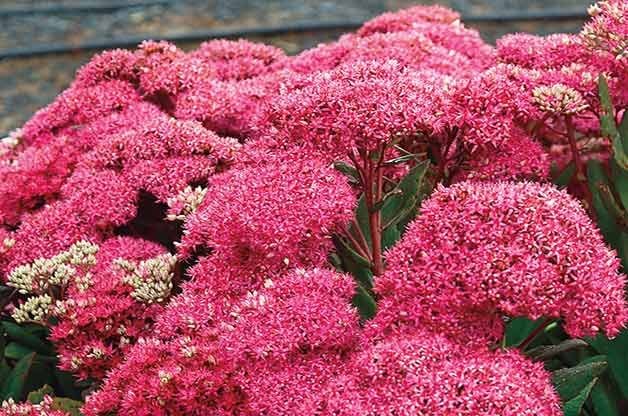
Sedum
Sedum
Zones 3 to 10
Take a close look and you’ll notice that this plant’s flower heads are made up of little star-shaped blooms. Since these flowering succulent plants range from 3 inches to 3 feet high, some species work well as ground covers, while others make excellent border plants.
Why we love it: One popular sedum variety, Autumn Joy, has broccoli-shaped light green flower heads that slowly change to pink and deepen to burgundy. Another gorgeous sedum is Mr. Goodbud. Later, the seeds feed hungry songbirds.
Here’s how to plant a gorgeous fall garden your birds will love.
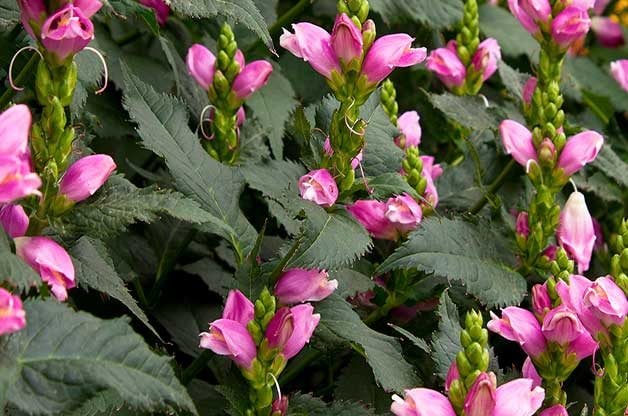
Hot Lips Turtlehead
Chelone Lyonii ‘Hot Lips’
Zones 3 to 8
The vibrant rosy-pink color is sure to lure you in for a closer look at the uniquely shaped flowers. Dark green leaves and eye-catching red stems add to this plant’s appeal. Grow this versatile fall blooming perennial plant in full sun to part shade. Psst—here’s more colorful shade garden plants.
Why we love it: The species is native to wet woodlands and streams, making it a great choice for those tricky areas with moist soil and rain gardens.
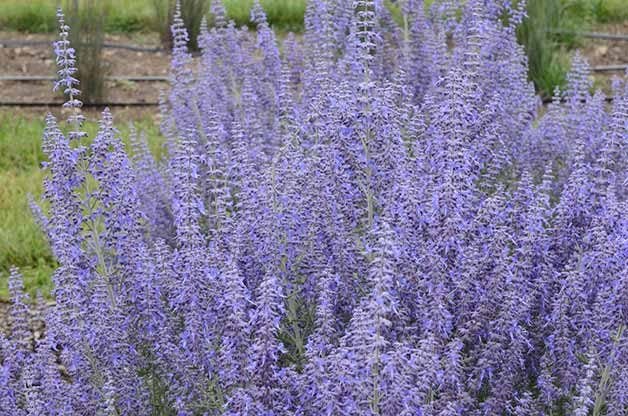
Russian Sage
Perovskia Atriplicifolia
Zones 4 to 9
Blue flowers shine from summer through fall on this stunning heat- and drought-tolerant plant. Grow in full sun and well-draining soil for best results. Prune Russian sage plants back to 4 inches in late winter or early spring for shorter growth. Or grow a compact variety such as Blue Spire, Lacey Blue or Denim ‘n Lace.
Why we love it: The fragrant foliage adds a bit of aromatherapy to your spring garden cleanup. Don’t miss the top 10 fall container plants for a pretty front porch.
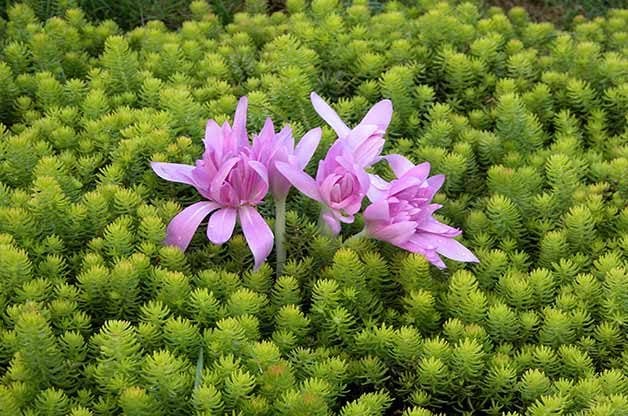
Waterlily Autumn Crocus
Colchicum ‘Waterlily’
Zones 4 to 7
Add a colorful surprise to the front of your garden with the large leafless blooms of Waterlily autumn crocus. Plant the bulbs in late summer and then enjoy the flowers right away in fall. Next spring, 6- to 14-inch tall leaves appear for about 8 weeks and then fade away for summer. Each fall, the flowers reappear, sans leaves. Learn why fall is the perfect time to plant perennials.
Why we love it: Autumn crocus looks great among flowering groundcovers.
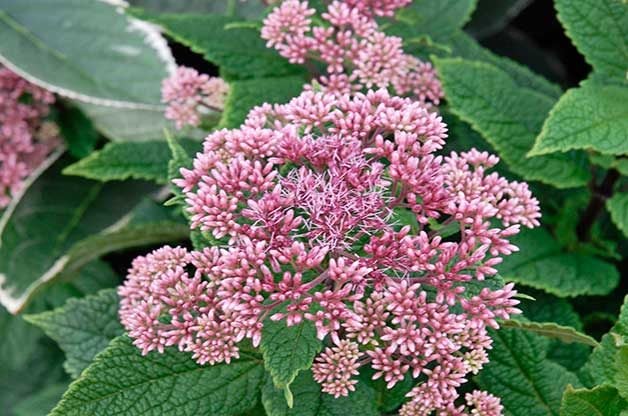
Joe Pye Weed
Eutrochium Purpureum
Zones 4 to 9
Give Joe Pye weed some room! These fall perennials reach 7 feet tall in full sun to partial shade and moist soil. You and the butterflies will fall in love with the large, fragrant mauve-pink flower clusters. Plus, the seed heads persist and add texture and interest to your winter garden. Plant these long-blooming flowers to attract butterflies and hummingbirds
Why we love it: For tight spaces, try Little Joe (3 to 4 feet tall) and Baby Joe (32 inches tall). Both of these smaller options are ideal for rain gardens or small garden beds. Discover more of the prettiest pink perennial flowers to grow.
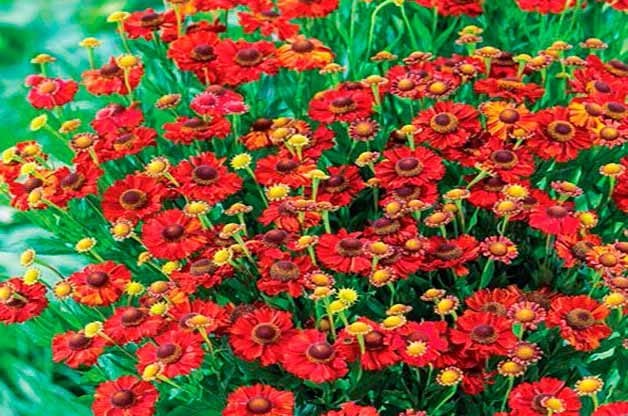
Hot Lava Helenium
Helenium ‘Hot Lava’
Zones 3 to 8
Hot Lava’s non-drooping, outstretches petals provide an ever-changing display of color through the blooming season. The daisy-like flowers open yellow, then develop orange and red streaks, and finally mature to red.
Why we love it: Dress up your indoor decor by adding these colorful blossoms to your fall bouquets. Check out the top flowers for a cutting garden.
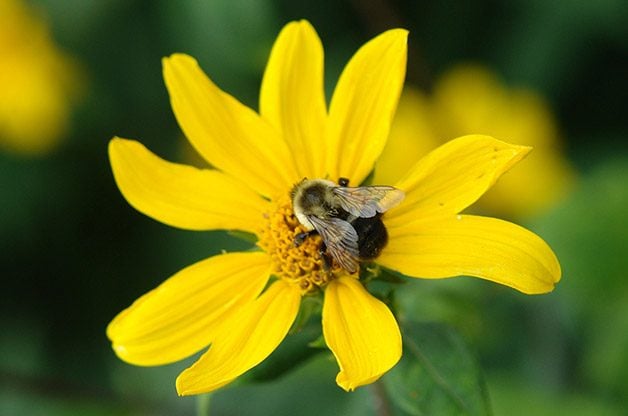
Lemon Queen Sunflower
Helianthus ‘Lemon Queen’
Zones 4 to 9
Save a spot in the back of the pollinator garden for this royal sunflower. Creamy yellow flowers top 6-foot-tall plants from late summer through fall. The upright, bushy plant provides a nice backdrop for neighboring flowers. Pinch the stems back throughout June if you want to keep your plant shorter.
Why we love it: Lemon Queen is great as a cut flower. Plus, hummingbirds and butterflies will gladly take advantage of the bright fall blooms. Discover more fall flowers that attract butterflies.
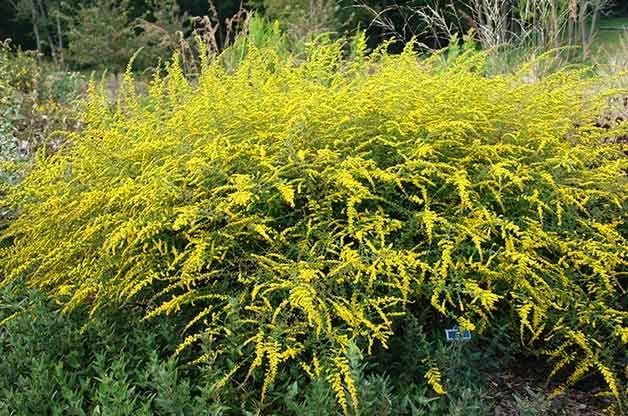
Fireworks Goldenrod
Solidago Rugosa ‘Fireworks’
Zones 4 to 9
An explosion of bright yellow flowers tops this 3-foot fall blooming perennial plant. Grow low-maintenance Fireworks in full sun or light shade. Contrary to popular belief, this is not the hay fever culprit. Ragweed, which is often found growing next to goldenrod, causes the sniffles. Learn how to grow wildflowers for butterflies.
Why we love it: Goldenrods are a great nectar and pollen source for fall’s flying pollinators, including bees and other beneficial insects.
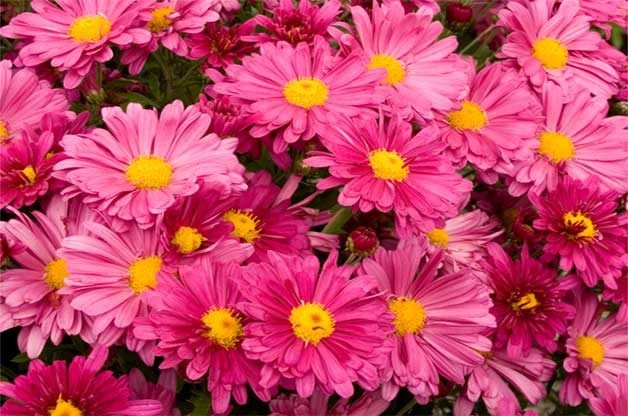
Mammoth Garden Mum
Chrysanthemum Morifolium ‘Mammoth’
Zones 3 to 9
Bred by the University of Minnesota, this hardy garden mum is right at home in both the north and south. Grow it in full sun in the garden or a container. This heavy fall blooming perennial produces plenty of flowers, so share fresh-from-the-garden bouquets with friends. Check out more easy plants you can grow in containers.
Why we love it: It’s a large mum that needs no early season pinching to stand upright in your autumn garden. Add drama with these bold burgundy perennial flowers.
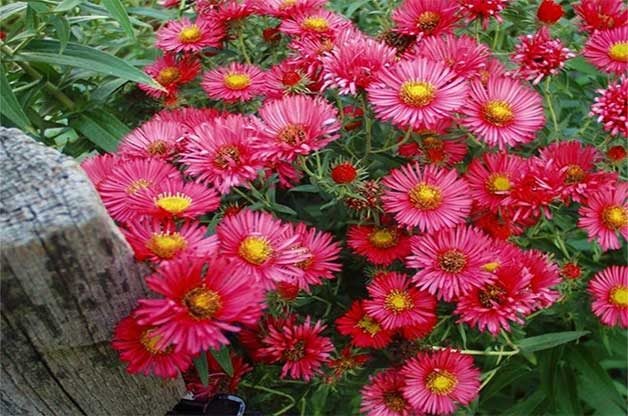
Alma Potschke Aster
Symphyotrichum Novae-Angliae ‘Andenken An Alma Potschke’
Zones 4 to 8
Plant these flowers in the front yard! Vivid rose-pink blooms on this New England aster will grab the attention of passerby and the neighbors. Pinch the stems back to 6 inches throughout June to encourage compact growth, sturdier stems and more flowers. Or let these fall perennials grow (up to about 4 feet tall!) and surround them with sturdy companion plants.
Why we love it: Birds and butterflies visit late-blooming asters, which adds motion and life to your backyard.
The infatuation with growing succulents started simply enough. Their tendency to thrive on inattention plus strong geometric shapes captured the attention of many gardeners. Now, the tough-as-nails plants are more popular than ever. Here’s how — and why — you should add succulents to your garden.
On This Page
Everything Gardeners Should Know About Growing Succulents

These drought-resistant, perfectly plump plants are both easy to care for and offer tons of flair. The range of colors—blue-green, lime, yellow, red, burgundy, pink and more —is matched only by the fascinating variety of leaf shapes, including rounded, ruffled, spiky and needlelike choices.
“They’re so textural and many plants have distinctive, unique looks, and that helped to propel succulents as ‘it’ plants,” explains Justin Hancock of Costa Farms, one of the world’s largest succulent and houseplant growers. With so many looks, there’s bound to be a succulent you fancy, whether it’s an upright African milk tree, low-mounding echeveria, or trailing elephant bush. Many make excellent indoor plants, preferring the dry, warm air typically found in homes.
Psst—here’s what I wish I knew before planting my succulent garden.
How (and Why) to Start Growing Succulents

Growing succulents is an excellent option for gardeners who love containers but don’t like the idea of watering them every day. These plants shine by themselves or with houseplant companions like snake plant, ZZ plant and ponytail palm. “They are a natural fit for container gardens, especially in hot, sunny spots that tend to dry out fast,” says Justin. “Low-growing varieties are fantastic as edging plants or in mass plantings for a look that doesn’t require a lot of care.” Happily, there are both tender and hardy succulents, so you can enjoy them in many different ways. Some succulents even attract pollinators.
Learn why a hens-and-chicks plant is a great option for a beginning succulent gardener.
Succulent Care and Watering

In general, succulents just need a few consistent conditions. “Bright light and well-draining potting mix or soil are a must,” Justin says. “Even though they’re touted as easy-care plants, most succulents will fail if their roots stay wet or they don’t get enough bright light.” Insert a toothpick into the drainage holes at the bottom of the pot to gauge how much water is in the soil. “If it comes out clean, the mix is dry and you should water your succulent,” says Justin. “If bits of potting mix are adhering to it, then there’s enough moisture and you probably don’t need to water just yet.”
Need succulent troubleshooting tips? Find out what’s wrong with your succulent and how to fix it.
Succulents grow slower than other plants—some don’t noticeably grow for months—so they don’t require much fertilizer. Feed them as infrequently as once or twice a year in spring or summer, or push them to grow faster by fertilizing every time you water. Just be sure to follow application rates on the fertilizer label.
Discover the top 10 flashy flowering succulents to grow.
Types of Succulents to Grow

Choose low-maintenance stunners from thousands of succulent options.
- Desert rose looks like a bonsai, so it’s perfect for creating textural contrast.
- Sunsparkler Blue Elf sedum is hardy, coming back every year in most regions, with blue-gray foliage and pink flowers.
- Haworthia fasciata, with dark green leaves and crisp white bands, is among the toughest succulents.
- Fantastic kalanchoe features green, paddlelike leaves edged with colorful cream, pink, red and purple streaks.
- Campfire crassula, with its rich green foliage, takes on bright orange and red tones in cool weather.
Next, check out these adorable succulent pots and planters.
Ragweed vs Goldenrod: What’s the Difference?

Ragweed and goldenrod look incredibly similar—but with an important difference. Ragweed is one of the most common causes of fall allergies. Goldenrod (which doesn’t cause sniffles) is an important source of pollen for helpful backyard pollinators, like moths and butterflies. If you spot a leggy plant with yellow or green flowers in your backyard or on a hike, don’t panic. Use these clues to figure out the difference between ragweed vs goldenrod.
Is Ragweed Related to Goldenrod?
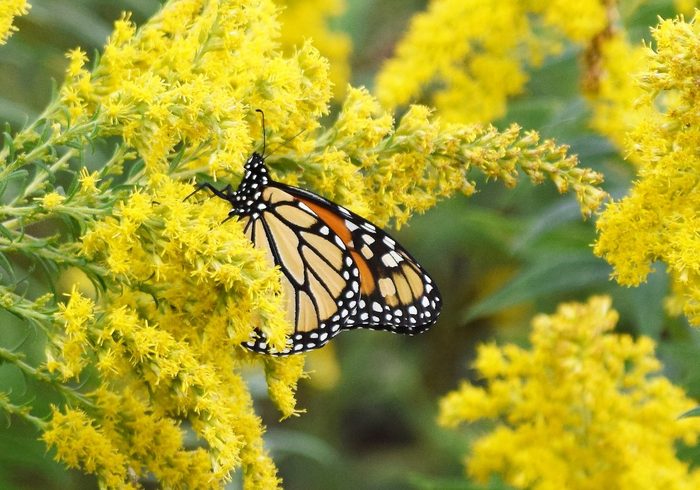
Despite the plants’ similar appearances, goldenrod and ragweed are not closely related. They’re both from the Asteraceae family which is made up of over 30,000 recognized plant species and the plants bloom in late-summer or fall.
Ragweeds are common lawn weeds, annuals and part of a group called Ambrosia. About 50 species make up the Ambrosia genus, but the most prevalent type is common ragweed.
Goldenrods are from the genus Solidago. It’s a larger group of flowering perennial plants that includes about 100 species.
Most ragweed and goldenrod plants are native and found all over North America, including wildflower meadows.
Leaves and Stems
Ragweed and goldenrod plants vary in size, so it’s impossible to identify a mystery plant by only height. Common ragweed tops out at only 2 to 3 feet, and goldenrod may be as short as 1 foot tall. At their largest, ragweed reaches 6 to 8 feet while goldenrod grows up to 6 feet tall.
Take a closer look at the foliage for more clues. Most ragweed plants have purple-tinted stems with lobed, fernlike green leaves. Goldenrods usually have green stems—although several types have hints of purple—and smooth, undivided green leaves.
Follow these tips and tricks for a weed-free backyard.
Ragweed vs Goldenrod Flowers

The potentially sneeze-inducing flowers are the easiest way to tell apart ragweed and goldenrod. Inspect the blooms for two traits: color and abundance.
Ragweed has small green-yellow flowers that blend in with the rest of the plant. Goldenrod plants feature many large clusters of bright yellow flowers and stand out among other green plants.
Discover the best natural way to kill weeds.
Will Pollinators Visit Ragweed and Goldenrod?

If your plant’s identity is still a mystery—sit back and watch for pollinators—and mourning doves. Goldenrod has the type of pollen that insects prefer, so gardeners are much more likely to see pollinators at goldenrod. It also produces nectar, so hummingbirds prefer these flowers.
Ragweed is generally visitor-free, because it doesn’t offer the right type of pollen. However, mourning doves happily eat seeds from ragweed plants.
Next, check out the best flowers that attract bees.
For a versatile shrub with interest in every season, look no further than summer-blooming Tianshan seven-son flower. This large upright shrub is easy to grow, attracts wildlife and works well as a garden centerpiece or as part of a naturalized hedge.
How to Grow Tianshan Seven-Son Flower

- Botanical name: Heptacodium miconioides ‘Minhep’
- Common name: Tianshan seven-son flower
- Zones: 5 to 9
- Light needs: Full sun to part shade
- Size: 8 to 12 feet high and 5 to 7 feet wide.
Tianshan seven-son flower can be grown two ways: as an upright, column-shaped shrub or a small tree. It looks fantastic as a single specimen plant or in an informal hedge, depending on how much time you’d like to devote to pruning.
However you decide to use this plant, it’s relatively easy to care for as long as it’s planted in the right conditions. It thrives in full sun and moist, well-draining soil, but it’s not a picky plant. Tianshan handles a few hours of shade a day and tolerates soils with a bit of clay or sand. It does well in acidic soils but can adapt to alkaline environments, as well. Many gardeners say that the shrub may benefit from a sheltered location.
Tianshan is relatively fast growing—it reaches its full size in 5 to 10 years. Once established, it’s relatively disease and pest free.
Follow our tips on planting shrubs and bushes when you’re ready to start digging.
Tianshan Seven-Son Flower in Spring and Summer
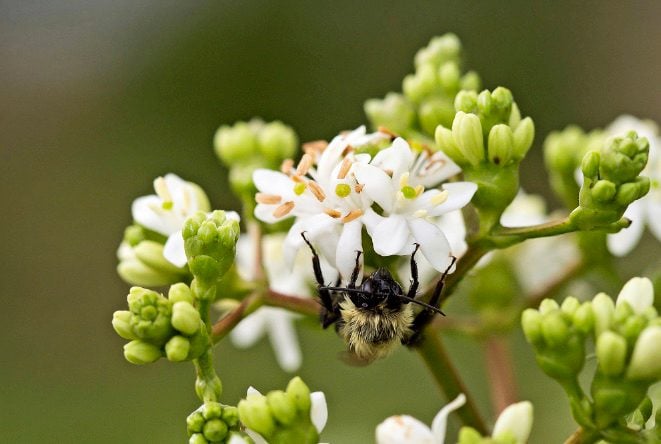
Truly a plant with four-season beauty, Tianshan seven-son flower offers interesting foliage, attractive flowers, and striking bark at different times of the year.
In spring, dark green foliage emerges from reddish-brown branches. The leaves are long, pointed and sport interesting veining. Nesting birds may appreciate the dense cover the shrub provides. Pair it with a spring flowering shrub like forsythia for a boost of color. In late summer, clusters of fragrant white flowers decorate the ends of the branches. The blooms look gorgeous against the background of shiny leaves and smell similar to jasmine or honeysuckle.
These white blossoms give seven-son flower its common name. Each whorl, which is an arrangement of leaves or flowers, features seven individual blooms. Gardeners aren’t the only ones who love the flowers. The blooms also attract helpful pollinators like bees, butterflies and hummingbirds.
Tianshan Seven-Son Flower in Fall and Winter
The late-summer flowers usher in the shrub’s most exciting season, but that’s not the end of the show. Tianshan offers plenty of pleasant surprises through winter and fall.
In autumn, pink calyxes appear as the white flower petals fall away and the dark green leaves fade to yellow. The colorful calyxes get larger as fall continues and turn a striking purple-red. Expect these jewel-toned accents to stick around until mid- to late fall. Even as winter arrives, Tianshan’s leaves drop and reveal one-of-a-kind exfoliating bark. The outer layer, which is tan and papery, slowly flakes off in thin strips and reveals streaks of the darker inner bark.
To best admire the interesting bark, plant Tianshan near a path or window for up-close viewing and consider pruning the lower branches in spring or late winter.
Where to Buy Tianshan Seven-Son Flower

Tianshan seven-son flower might be available at your local garden center. Call ahead to check for availability. You can also purchase it from an online retailer.

All About Garden Phlox
If you’re searching for a fragrant flower that looks gorgeous while drawing multiple pollinators to your yard, look no further. The stunning pink (or white!) blooms of garden phlox add interest to your garden while boasting a sweet scent that’ll make you smile every time you walk past. Here’s all you need to know about adding this flower to your yard.
Garden Phlox Flower Care
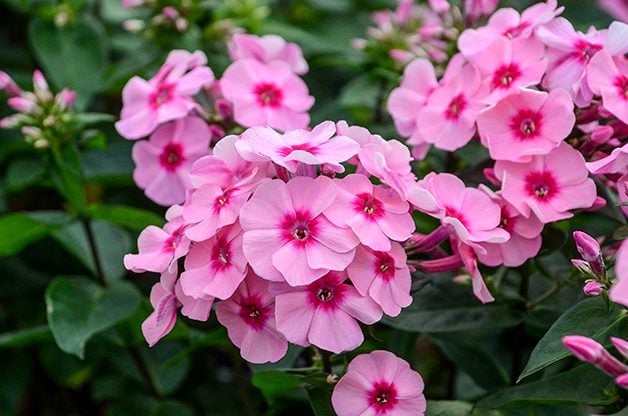
Before you add this gorgeous flower to your garden, take a look at the information below.
Scientific name: Phlox paniculata
Growing zones: Zones 4 to 8
Light needs: Prefers full sun, but also grows in part shade.
Size: 2 to 4 feet tall, and spreads nearly as wide.
Grown for: Fragrant and showy white, pink or purple flowers.
Foliage: Long, pointed leaves.
Native to the rich thickets of the eastern states, garden phlox is equally at home in most of the U.S. It’s a great pick to add to the middle or the back of a garden border, and it adds color in summer and fall. It’s also an excellent choice for a cut flower garden.
Densely packed flowers pop up later in the growing season, usually around July, and keep blooming for about two months until early fall. Garden phlox is susceptible to powdery mildew, but look for cultivars that are slightly more resistant. Thin out half of the new stems in spring for better air circulation, which minimizes mildew risk.
Check out the top 10 flowering perennials that bloom all summer.
Benefits of Growing Garden Phlox

Regardless of the color of flowers that you plant, white or pink petals will draw in pollinators equally well. Hummingbirds, bees and butterflies adore the fragrant blooms. It’s a perfect choice for a butterfly garden.
For more plants that bring in hummingbirds, check out our roundup of the top colorful hummingbird plants to grow.
Garden Phlox Cultivars To Try

There are plenty of types of this flower you can add to your garden. Candy Stripes boasts fun, contrasting stripes, and Mother of Pearl wows with overlapping blush pink blooms. Glowing white David is unique because it offers resistance to powdery mildew.
Fun Facts About Carrots
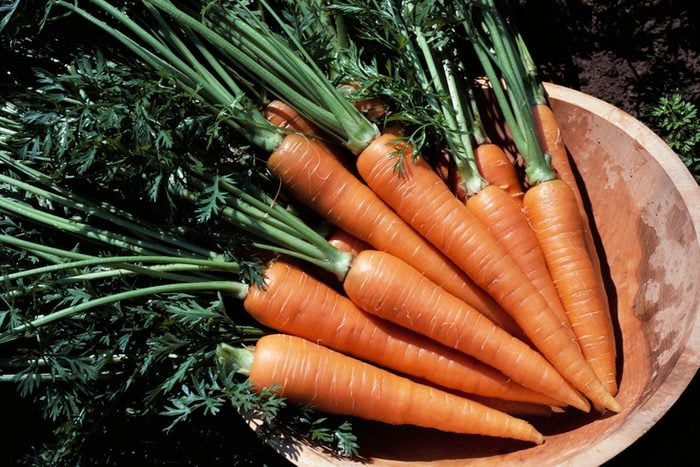
Few vegetables are as versatile as carrots. They’re equally at home in desserts like carrot cake as they are in casseroles, and, of course, being taken straight from the fridge and dunked in ranch dressing. It’s no wonder many gardeners add carrots to their yearly harvest — there’s so much you can do with them! In celebration of the iconic veggie, here’s a collection of fun carrot facts.
Carrots Are Older Than You Think
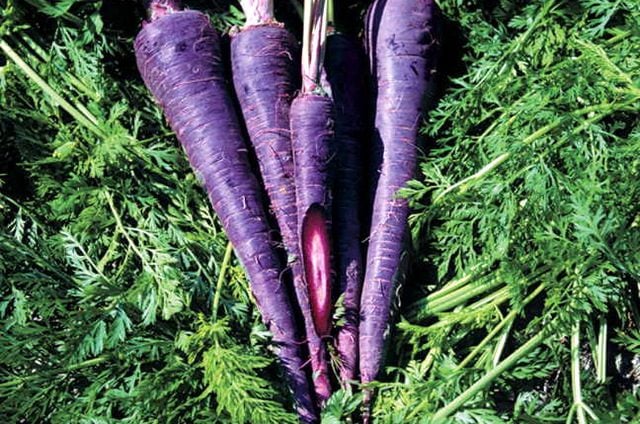
Despite their prominence in modern grocery stores, orange carrots emerged in the 1600s. Purple and yellow were once the most prevalent colors, and today, heirloom varieties have made a big comeback.
We Eat a Lot of Carrots!

The average person eats more than 10,000 of these sweet, crunchy vegetables in their lifetime. On a yearly basis, folks munch on 8.3 pounds of fresh carrots, and consume 1.4 pounds of the veggie from the freezer.
Learn how to store vegetables so they stay fresh longer.
Carrots Are Very Good for You

To those who know about nutrition, this’ll probably be the least surprising of our carrot facts. These orange vegetables are an incredible source of nutrients like beta carotene, vitamin C and potassium, but they’re especially high in vitamin A. Even just half a cup of cooked or raw carrots contains about 204% of your recommended daily value.
Discover 20 mental and physical health benefits of gardening.
The Carrot “Life Cycle” Takes Two Years

Carrots, a biennial vegetable, have a life cycle that takes two years. If you leave a healthy carrot in the ground, its top will bloom and produce a round of seeds in its second year. Learn more about growing carrots.
Most of the Carrots in the U.S. Are Grown in One State

More than 85% of carrots in the U.S. are grown in California—the city of Holtville, California, calls itself the carrot capital of the world. Michigan and Texas are also among the top carrot-growing states.
Next, check out 10 fast-growing vegetables you can harvest quickly.
Succulents are unique, eye-catching plants that come in a huge variety of sizes, shapes, blooms and bold foliage colors. In practice, they’re just as versatile: succulents can thrive in an outdoor perennial garden, window box or indoor pots.
Succulents are considered low-maintenance: they’re fairly drought-tolerant, and with the right care they will reward you with pleasing displays of foliage and blooms. Our easy guide teaches you how to take care of succulents, no matter how experienced a gardener you are.
How Often Do You Water Succulents?
When it comes to the amount of water succulents need, the answer can sound both obvious and vague: not too little but not too much. So how do you find that perfect balance?
Your watering schedule should be guided by the seasons. Generally speaking, you should water succulents thoroughly once a week during warm and hot weather. During spring and fall, reduce frequency to twice a month, and then once a month in winter. For outdoor plants, keep rainfall in mind, and skip watering on wet weeks.
When you water, give succulents a thorough soaking. Succulents aren’t fans of small sips! Water until the soil is evenly saturated, whether you use a watering can, hose or sprinkler. For succulents in containers, water from the top and continue until water flows from the drainage holes in the bottom of the pot. Empty the tray to prevent soggy soil soaking the roots.
If you’re in doubt, let the soil guide you. Poke the soil with your finger. Does it feel grainy and dry? It’s ready to water. Is it more like a damp sponge? Wait a while.
The leaves can also tell you if the plant is thirsty. Succulents store their water supply in their stems and leaves, so if the leaves are looking withered or shriveled, that is a good indication your plant is in need of water.
Discover the top 10 flashy flowering succulents to grow.
How Much Light Do Succulents Need?

Make sure your succulents get about six hours of sunlight a day. When planting a succulent in the garden, choose a location that will provide sufficient light, but avoid spots where the plant will get too much intense sun exposure, as the leaves will become scorched. Plants need sun protection too! If your garden is very sunny, plant succulents near a source of shade to give them a break.
Want to make sure your plant will thrive? Select a spot in the garden for a new succulent, and leave it in the pot for a week or two. Notice how much light the plant gets, and how it responds to the location. You can easily move the pot to find the best location before planting in the garden.
Make sure to avoid these succulent garden mistakes.
Do Succulents Need Fertilizer?
Succulents don’t require rigorous fertilization, but they can use a little boost now and then. Potted plants can especially benefit, as their soil will get depleted over time. Only use fertilizer during periods of growth (generally in the spring through early summer). Go gently! Dilute commercial fertilizer with water (follow the package directions) for a light feed that won’t burn the plants. (You can propagate succulents during the growing season, too!)
Here’s everything you need to know about growing succulents.
What Container Should I Plant Succulents In?
No matter how plain or stylish your succulent pot, it should have drainage openings to allow extra water to flow from the pot. Terracotta pots are a great choice for succulents since they help with even moisture retention and evaporation.
For in-ground plants, be sure to give the roots the best drainage possible. Excess moisture in the soil can lead to an unhappy plant and root rot.
For all succulents, plant in coarse soil that will drain quickly. Not all garden and potting soil is created equal.
Psst—we’re hopping with excitement over this adorable bunny succulent
How to Transplant Succulents

No gardener wants to leave a plant that isn’t doing well in a spot in the garden or container out on the patio. Sometimes a changed location or a fresh batch of soil can do wonders to revive a fading plant. You may also want to transplant a succulent that’s outgrown its pot.
Dig the succulent out of the garden soil, or carefully tip it from its container. Gently tap to remove any excess soil around the roots. Cut off any brown or black roots that look like they have rotted. Place the plant on a mesh strainer or newspaper to give the roots a chance to air dry for two to three days.
Re-plant a garden plant directly in the ground, making sure to dig a deep enough hole to set the roots in without crushing them. Lightly tap the soil over the plant.
For a potted plant, re-pot into a container that’s only one size larger than the former pot, or you may shock the plant. Fill the bottom of the pot with fresh soil, set the plant inside and pour soil to fill the pot.
With the right care, your succulents will be a beautiful addition to your healthy garden. They may even attract pollinators!